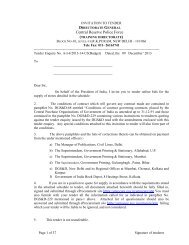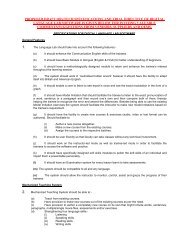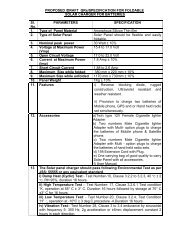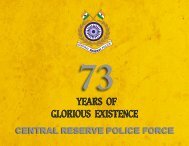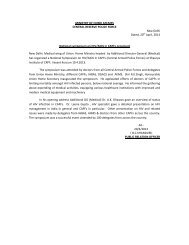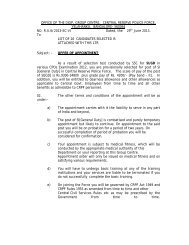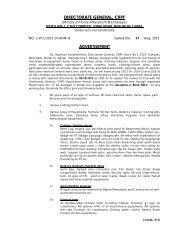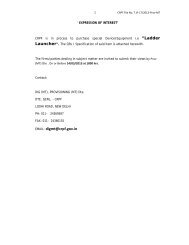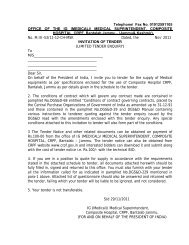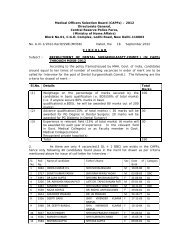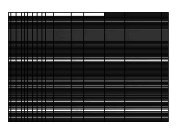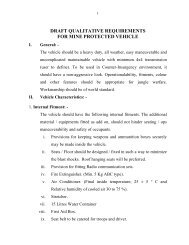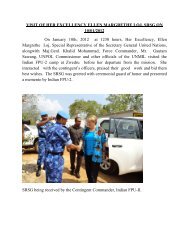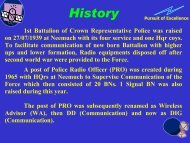crpf samachar may_ june-2012 - Central Reserve Police Force
crpf samachar may_ june-2012 - Central Reserve Police Force
crpf samachar may_ june-2012 - Central Reserve Police Force
Create successful ePaper yourself
Turn your PDF publications into a flip-book with our unique Google optimized e-Paper software.
precisely timing the signals sent by GPS satellites<br />
high above the Earth. Each satellite continually<br />
transmits messages that include<br />
� the time the message was transmitted<br />
� satellite position at time of message transmission<br />
The receiver uses the messages it receives to<br />
determine the transit time of each message and<br />
computes the distance to each satellite. These<br />
distances along with the satellite’s locations are used<br />
with the possible aid of trilateration (In geometry,<br />
trilateration is the process of determinating absolute<br />
or relative locations of points by measurement of<br />
distances, using the geometry of circles, spheres or<br />
triangles), depending on which algorithm is used, to<br />
compute the position of the receiver. This position is<br />
then displayed, perhaps with a moving map display<br />
or latitude and longitude; elevation information<br />
<strong>may</strong> be included. Many GPS units show derived<br />
information such as direction and speed, calculated<br />
from position changes. Three satellites might seem<br />
enough to solve for position since space has three<br />
dimensions and a position near the Earth's surface<br />
can be assumed. However, even a very small clock<br />
error multiplied by the very large speed of satellite<br />
signals results in a large positional error. Therefore<br />
receivers use four or more satellites to solve for<br />
both the receiver's location and time.<br />
Structure<br />
The current GPS consists of three major<br />
segments. These are the space segment, a control<br />
segment, and a user segment. The U.S. Air <strong>Force</strong><br />
develops, maintains, and operates the space and<br />
control segments. GPS satellites broadcast signals<br />
from space, and each GPS receiver uses these<br />
signals to calculate its three-dimensional location<br />
(latitude, longitude, and altitude) and the current<br />
time.<br />
The space segment is composed of 24 to 32<br />
satellites in medium Earth orbit and also includes<br />
the payload adapters to the boosters required to<br />
launch them into orbit. The control segment is<br />
composed of a master control station, an alternate<br />
ebZ&twu <strong>2012</strong><br />
Technical Feature<br />
master control station, and a host of dedicated and<br />
shared ground antennas and monitor stations.<br />
The user segment is composed of hundreds of<br />
thousands of U.S. and allied military users of the<br />
secure GPS Precise Positioning Service and tens of<br />
millions of civil, commercial, and scientific users of<br />
the Standard Positioning Service.<br />
Communication<br />
The navigational signals transmitted by GPS<br />
satellites encode a variety of information including<br />
satellite positions, the state of the internal clocks,<br />
and the health of the network. These signals are<br />
transmitted on two separate carrier frequencies<br />
that are common to all satellites in the network.<br />
Two different encodings are used: a public encoding<br />
that enables lower resolution navigation, and an<br />
encrypted encoding used by the U.S. military.<br />
All satellites broadcast at the same frequencies<br />
1.57542 GHz (L1 signal) and 1.2276 GHz (L2<br />
signal). Signals are encoded using code division<br />
multiple access (CDMA) allowing messages from<br />
individual satellites to be distinguished from each<br />
other based on unique encodings for each satellite<br />
(that the receiver must be aware of). Two distinct<br />
types of CDMA encodings are used: the coarse/<br />
acquisition (C/A) code, which is accessible by the<br />
general public, and the precise (P) code, that is<br />
encrypted so that only the U.S. military can access<br />
it.<br />
Because all of the satellite signals are modulated<br />
onto the same L1 carrier frequency, the signals<br />
19



